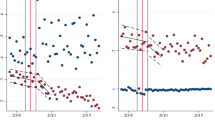Abstract
We develop a model of risk assessment that incorporates assumptions from the behavioral theory of the firm into conventional expected utility models of compliance, and test the model using data on injuries and OSHA inspections for 6842 manufacturing plants between 1979 and 1985. Four hypotheses are supported-the specific deterrence effect of an inspection, the importance of lagged effects of general deterrence, the asymmetrical effects of probability and amount of penalty on injuries, and the tendency of injury rates to self-correct over a few years. The model estimates that a 10% increase in enforcement activities will reduce injuries by about 1% for large, frequently inspected firms. Prior analyses reporting lower impacts (Smith, 1979; Viscusi, 1986a) are replicated to distinguish between sampling and modeling differences. The results suggest that further compliance theory needs more detailed models of risk-assessment processes to be tested on samples of firms most affected by enforcement.
Similar content being viewed by others
References
Bartel, Ann, and Lacy G., Thomas. (1985). “Direct and Indirect Effects of OSHA Regulation,” Journal of Law and Economics 28, 1–26.
Becker, Gary S. (1968). “Crime and Punishment: An Economic Approach,” Journal of Political Economy 76, 169–217.
Casey, Jeffrey, and John t. Scholz. (1990). “Boundary Effects of Vague Risk Information on Taxpayer Decisions,” forthcoming in Organizational Behavior and Human Decision Processes.
Cook, William N., and Frederick H., GautschiIII. (1981). “OSHA, Plant Safety Programs, and Injury Reduction,” Industrial Relations 20, 245–257.
Cyert, Richard, and James G., March. (1963). A Behavioral Theory of the Firm. Englewood Cliffs, NJ: Prentice Hall.
Downing, Paul B., and Kenneth, Hanf (eds.). (1983). International Comparisons of Pollution Enforcement. Boston: Kluwer-Nijhoff Publishing.
Erlich, Isaac. (1973). “Participation in Illegitimate Activities: A Theoretical and Empirical Investigation,” Journal of Political Economy 81, 521–565.
Fellegi, Ivan P., and Alan B., Sunter. (1969). “A Theory of Record Linkage,” Journal of the American Statistical Association 64, 1183–1210.
Gray, Wayne B. (1987). “OSHA MIS Matching Techniques,” mimeo.
Kahneman, Daniel, Paul, Slovic, and Amos, Tversky. (1982). Judgement under Uncertainty: Heuristics and Biases. New York: Cambridge.
Klepper, Steven, and Daniel, Nagin. (1989). “Tax Compliance and Perceptions of the Risks of Detection and Criminal Prosecution,” Law and Society Review 23, 209–240.
Lempert, Richard. (1982). “Organizing for Deterrence,” Law and Society Review 16, 513–568.
McCaffrey, David. (1983). “An Assessment of OSHA's Recent Effects on Injury Rates,” Journal of Human Resources 18, 131–146.
McCaffrey, David. (1982). OSHA and the Politics of Health Regulation. New York: Plenum Press.
Mendeloff, John. (1979). Regulating Safety: An Economic and Political Analysis of Occupational Safety and Health Policy. Cambridge, MA: MIT Press.
Nagin, Daniel. (1978). “General Deterrence: A Review of the Empirical Evidence.” In Al, Blumstein, J. Cohen, and Daniel, Nagin (eds.), Deterrence and Incapacitation: Estimating the Effect of Criminal Sanctions on Crime Rates. Washington, DC: National Academy of Sciences.
Ostrom, Charles W. (1978). Time Series Analysis: Regression Techniques Beverly Hills: Sage.
Radner, Roy. (1975). “A Behavioral Model of Cost Reduction,” Bell Journal of Economics 6, 196–215.
Ruser, John W., and Robert S., Smith. (1988). “The Effect of OSHA Records Check Inspections on Reported Occupational Injuries in Manufacturing Establishments,” Journal of Risk and Uncertainty 1, 415–435.
Schoemaker, Paul J. (1982). “The Expected Utility Model: Its Variants, Purposes, Evidence and Limitations,” Journal of Economic Literature 20, 529–563.
Scholz, John T. (1984a). “Cooperation, Deterrence, and the Ecology of Regulatory Enforcement,” Law and Society Review 18, 601–646.
Scholz, John T. (1984b). “Reliability, Responsiveness, and Regulatory Policy,” Public Administration Review 44, 145–153.
Scholz, John T. (1987). “Bureaucratic Environments and Regulatory Enforcement Effectiveness: A Theory of Cooperative Enforcement,” paper delivered at APSA Annual Meeting.
Smith, Robert S. (1979). “The Impact of OSHA Inspections on Manufacturing Injury Rates,” Journal of Human Resources 14, 145–170.
Smith, Robert S. (1976). The Occupational Safety and Health Act: Its Goals and its Achievements. Washington, DC: American Enterprise Institute.
Stern, Paul C. (1986). “Blind Spots in Policy Analysis: What Economics Doesn't Say about Energy Use,” Journal of Policy Analysis and Management 5, 200–227.
Viscusi, W. Kip. (1979). “The Impact of Occupational Safety and Health Regulation,” Bell Journal of Economics 10, 117–140.
Viscusi, W. Kip. (1986a). “The Impact of Occupational Safety and Health Regulations, 1973–1983,” Rand Journal of Economics 17, 567–580.
Viscusi, W. Kip. (1986b). “Reforming OSHA Regulation of Workplace Risks.” In L., Weiss and M., Klass (eds.), Regulatory Reform: What Actually Happened. Boston: Little, Brown and Co.
von, Neuman, John, and Oskar, Morgenstern. (1947). Theory of Games and Economic Behavior, 2nd edition. Princeton: Princeton University.
Author information
Authors and Affiliations
Additional information
This project would not have been possible without the cooperation of the Bureau of Labor Statistics and the Occupational Safety and Health Administration. Special thanks are due to William Eisenberg at BLS and Frank Frodyma and Joe Dubois at OSHA. We are particularly indebted to John Ruser of BLS, who performed the data merging and solved numerous problems. The project was partially funded by NSF grant SES8420920. These individuals and institutions do not necessarily support the conclusions in this article.
Rights and permissions
About this article
Cite this article
Scholz, J.T., Gray, W.B. OSHA enforcement and workplace injuries: A behavioral approach to risk assessment. J Risk Uncertainty 3, 283–305 (1990). https://doi.org/10.1007/BF00116786
Issue Date:
DOI: https://doi.org/10.1007/BF00116786




